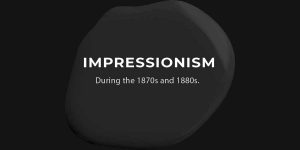Within the context of man-made environment and natural world there is a documented human cognitive preference for golden section proportions throughout recorded history. Some of the earliest evidence of the user of Gold section rectangle , with the proportion of 1:1.618, is documented in the architecture of stonehenge built in the twentieth to 16th centuries, B.C. Further documented evidence is found in the writing, art & architecture of the ancient greeks in 5th century B.C.. Later, Renaissance artists and architects also studied, documented and employed gold section proportions in remarkable works of Sculpture, painting and architecture. In addition to man-made works, golden section proportion can also be found in natural world through human proportions and the growth patterns of may living plants, animals and insects.

Two numbers are considered to be in the golden ratio in mathematics if their ratios match up with the ratio of their sums to the greater of the two numbers.
Decimal: 1.618033988749894…
Binary: 1.10011110001101110111
Hexadecimal: 1.9E3779B97F4A7C15
Golden section proportions, also known as the golden ratio, are those that fall in the proportion of 1:1.618. Some of the earliest known recorded examples of these proportions come from ancient Greece and include the Parthenon and other sculptures created by artists such as Phidias and Iktinos, as well as many others like them throughout different societies and cultures around the world. The key question that we need to ask ourselves today is whether or not we can take advantage of this phenomenon? If so, how?
The Golden Ratio in Nature
Evidence suggests that certain golden section proportions appear in natural objects around us. The classical example is our own bodies—when we divide our body into extreme ratios, we end up with golden section proportions. To test your own theories, consider taking an art foundation course or an art class to learn more about proportions and why they’re important. Start by drawing a human figure and divide it into different segments; you might be surprised at how often you see what you might call golden. You can also find many examples of these ratios in nature by looking at photographs taken in zoos or on nature walks. Some animals’ faces and ears are divided according to the golden ratio. For instance, bees have a 1:1.618 ratio for their antennae lengths and dogs have 1:1.618 for their ear width to height ratios in relation to their head size.
Golden section preferences are not just confined to human aesthetics; they also play a significant role in the fascinating interaction between the proportion of growth patterns in living things like plants and animals. The spiral contours of shells reflect cumulative patterns of growth, and these growth patterns have been the focus of numerous artistic and scientific investigations. Theoretically, a perfect growth pattern, logarithmic spirals with Golden section proportions make up the growth patterns of shells. Theodore Andreas describes these growth patterns in his book “The curves of Life”, he describes these growth patterns as “ essentials processes of life…”
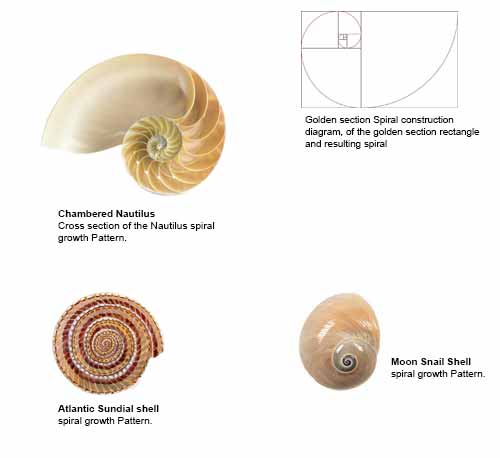
The new spiral in each spiral-shaped growth phase closely resembles the percentage of the previous spiral’s Golden section square that was greater. The development patterns of nautilus shells and other shells are never precisely proportioned to a golden section. Instead, there is an attempt to approximate, but never quite reach, the exact golden spiral proportions in biological growth pattern proportion.
Tibia shell spiral growth pattern and golden section proportions
Pentagon Pattern
The pentagon and star pentagram have golden section proportions, as the ratios of the sides of the triangle is a star pentagram is 1:1.618. The same pentagon/pentagram relationships can be found in the sand dollar and in snowflakes.

Many living creatures, including sand dollars, have shapes similar to the pentagon and pentagram star, which also have golden section proportions. The ratio of any two lines within a star pentagram is the golden section proportion of 1:1.68. The interior subdivisions of a pentagon produce a star pentagram.

Analysis of a Rainbow trout: Three golden segment rectangles enclose the Trout’s body. The tail fin is formed by a reciprocal golden rectangle, and the eye is at the level of that rectangle.
Human Body Proportions in Classic Sculptures
The golden section proportions are seen in many sculptures, particularly in Greek works. Ancient sculptures such as Daedalus and Icarus by Praxiteles used a composition based on four rectangles with sides in golden ratio to each other. It is also found in Venus de Milo. The Mona Lisa is another painting which uses these proportions, especially apparent when it is slightly larger than life size. Many architects and designers take advantage of this proportion, even if they are not aware that they are doing so, due to its pleasing aesthetic quality.
Humans share the same golden section proportions as numerous plants and animals. The fact that the human face and body share the same mathematical proportional relationships seen in all living things may be another explanation for the cognitive preference for golden section proportions. Humans share the same golden section proportions as numerous plants and animals. The fact that the human face and body share the same mathematical proportional relationships seen in all living things may be another explanation for the cognitive preference for golden section proportions.
The writings of ancient Greek scientist and architect Matcus Vitruvius Pollio, also known as Vitruvius, provide some of the earliest extant documented studies on human proportion and architecture. He suggests that temple construction be modelled after the perfectly balanced human body, where harmony prevails between all of the parts. He explained this ratio as well as the height of his extended arms.

The investigation of the proportions utilised in the statues of the Spear Bearer and Zeus shows that they are both obviously based on Vitruvius’s canon. The human body is enclosed by a square that is formed by the height and length of the body and the extended arms. In a circle with the navel at its centre, while hands and feet are in contact. The human shape is split in half within this system at the groin and by the golden part at the navel. The investigation of the proportions utilised in the statues of the Spear Bearer and Zeus shows that they are both obviously based on Vitruvius’s canon.
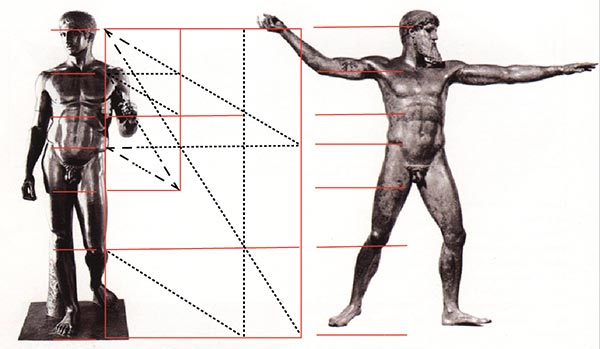
Golden Section Proportions of Greek Sculpture.
Doryhoros, the spear Bearer (Left). Statue of Zeus from cape artemision (right). Each golden section rectangle is represented by rectangle with dashed diagonal line. Multiple golden section rectangles share the dashed diagonal. The proportions of the two figures are almost identical.
Golden Section Proportion in Fine Art
According to numerous sources, the Golden Ratio is the ratio of height to width of a rectangle drawn around the face of Leonardo da Vinci’s Mona Lisa. There is no proof that Leonardo was aware of the Golden Ratio or where exactly the rectangle should be drawn when he composed the Mona Lisa. However, it must be noted that Luca Pacioli, who wrote a three-volume treatise on the Golden Ratio in 1509, was a close personal friend of Leonardo (entitled Divina Proportione).
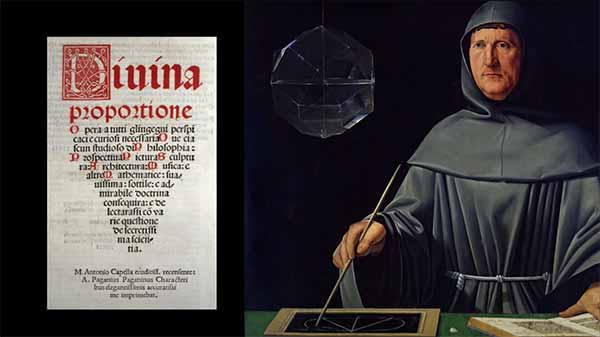
Salvador Dali, a surrealist painter, is another whose use of the Golden Ratio in his works has been shown beyond a shadow of a doubt. The Golden Ratio is represented by the proportions in Dali’s painting Sacrament of the Last Supper. In addition, Dali included a massive dodecahedron (a twelve-faced Platonic solid with a pentagon on each side) encompassing the dinner table.
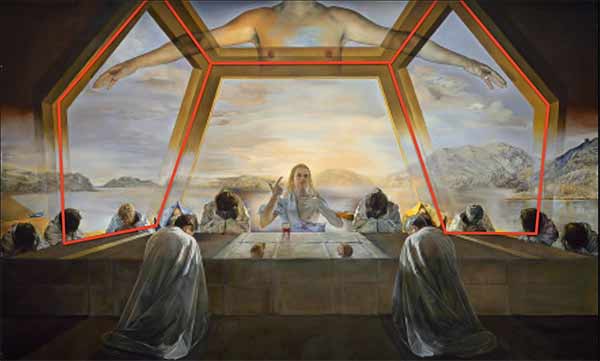
The dodecahedron is closely related to the Golden Ratio since its surface area and volume are both straightforward functions of the ratio. According to Plato, the dodecahedron is the solid “that the gods used for embroidering the constellations on the whole heaven.”
In terms of the Golden Ratio’s appearances in the arts, these two instances are merely the top of the iceberg. Le Corbusier, a well-known Swiss-French painter and architect, created the “Modulor,” a complete proportional system that was based on the Golden Ratio.
The Modulor was designed to offer a uniform method that would automatically give everything, from door knobs to high-rise buildings, harmonic proportions. But why would any of these artists—and there are many more than those who were named above—even think to include the Golden Ratio in their creations? In an effort to find an answer, several psychological studies have been conducted in an effort to determine whether there is any connection between how people perceive “beauty” and mathematics.
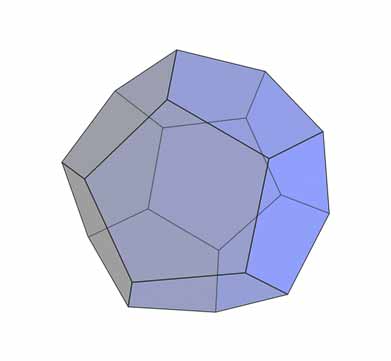
Dodecahedron Properties
How To Apply the Golden Ratio to Design
Art has always been a part of our human existence. While technology makes it easier to create art, we still seek to create art that is timeless and expressive. The Golden Ratio plays an important role in creating art that fits these characteristics. In order to apply these principles effectively, you should have an understanding of what exactly they are and how they’re used. In short, these ratios – 0.618 to 1 for length and 0.618 to 1 for width – divide a shape or structure into two sections that relate in proportion with each other. While studying art foundation course , most people tend not to pay attention in their classes regarding measurement and proportion; however, if you apply them properly, they will help you take your design game up several notches!
Our foundation course will teach students how to understand these principles and make use of them in their artwork. BrainArt classes even offer courses in how to design artwork using the Golden Ratio by considering natural light and colors found at different times of day, which would result in more cohesive pieces


